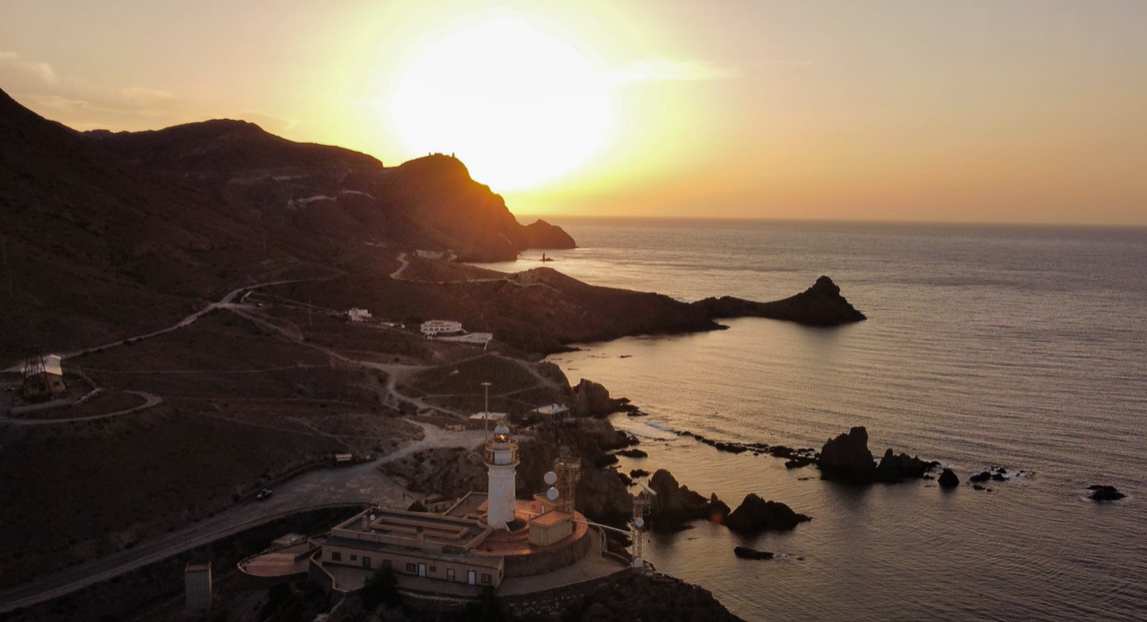If you’ve ever fancied swapping hotel balconies for star-filled skies, or trading air con for a fresh sea breeze, then Camping Cabo de Gata and its surrounding sites are calling your name. Now, it’s well known I am not into camping, but I have several friends who are and they love it.
This rugged, sun-baked corner of Almería is Spain’s last great coastal wilderness, and sleeping out here—whether you’re in a tent, campervan, or comfy bungalow—is all part of the magic. Here, it’s all about crashing waves, quiet coves, and waking up to the scent of wild thyme and salty air.

Getting to Cabo de Gata & Public Transport Options
Closest Airport:
Almería Airport (LEI)—roughly 30-40 minutes by car to most campsites in the area.
By Public Transport:
- Buses run from Almería city to San José, Cabo de Gata village, and nearby towns, though connections are limited.
- If you’re camping and carrying gear, a hire car is strongly recommended to fully explore the park’s hidden spots.
Top Camping Spots in and Around Cabo de Gata
1. Camping Cabo de Gata (Cabo de Gata Village)
This is the area’s best-known campsite—yes, it’s literally called Camping Cabo de Gata—located near the small fishing village of Cabo de Gata itself.
What to Expect:
- Large shady pitches, bungalows, and glamping tents
- A huge pool (very welcome in summer)
- On-site restaurant, shop, and bar
- Ideal base for the nearby Salinas de Cabo de Gata salt flats (flamingo-spotting heaven)

FAQs:
- Best Time to Visit: April to June or September—warm but not too crowded.
- Parking: Ample parking, with plenty of space for motorhomes.
- Accessibility: Flat and accessible for wheelchairs and mobility scooters.
- Best Viewpoint: The nearby Mirador de las Salinas overlooks the wetlands, with flamingos galore.
- Local Market: The village itself is quiet, but Almería city’s bustling market is about 30 minutes away.
Boat Trips:
From the nearby beaches and Almería city, you can hop on sailing trips and kayak tours around the cliffs and hidden beaches of Cabo de Gata.
2. Camping Los Escullos (Near San José)
If you’re after something with a bit more of a remote feel—but still with mod cons—head to Camping Los Escullos, tucked between the dramatic cliffs of Los Escullos and Isleta del Moro.

What to Expect:
- Pitches, cabins, and mobile homes
- A restaurant serving hearty local dishes, supermarket and bike rentals
- Swimming pool ( it’s huge! ), gym, and even a sauna
- Fantastic access to remote beaches like Playa del Arco and Cala del Carnaje

FAQs:
- Best Time to Visit: Late spring and autumn—perfect for hikes and beach days.
- Parking: No issues here, even for large campervans.
- Accessibility: The campsite itself is flat, though the nearby beaches may involve rocky paths.
- Best Viewpoint: The ruins of Castillo de San Felipe offer sea views that’ll make your Instagram followers jealous.
- Local Market: San José’s Tuesday market is nearby, with crafts, food, and plenty of local chatter.
Boat Trips:
You’re just a short drive from San José’s marina, where kayaking and boat tours take you around remote coves and sea caves.
3. Camping Tau (San José)
For those who prefer being closer to bars, shops, and tapas without sacrificing nature, Camping Tau in San José is a solid option.
What to Expect:
- Cosy campsite under pine trees
- Walkable to Playa de los Genoveses and Playa de Mónsul
- Simple facilities but a friendly, communal vibe
- Great for hikers and those who want to ditch the car for a few days
FAQs:
- Best Time to Visit: May-June or September-October—balmy days, cool nights.
- Parking: Limited inside the site but street parking nearby.
- Accessibility: Mostly flat but with some gravel paths.
- Best Viewpoint: Head to Mirador de la Amatista for sweeping views over the cliffs and turquoise sea.
- Local Market: San José’s lively Tuesday market is just a stroll away.

Boat Trips:
You’re right by San José’s harbour—sign up for a kayak tour or hop on a boat for a trip along the coast toward Cala Higuera or the hidden beaches beyond.
Hiking, Wildlife & Hidden Gems
Camping here isn’t just about lazy beach days (though there’s plenty of that too). Cabo de Gata is criss-crossed with walking trails, offering everything from quick coastal strolls to challenging treks.
Expect to see:
- Flamingos in the salt flats
- Spanish ibex clambering on the cliffs
- Endless wildflowers in spring
- Dolphins playing in the bay (if you’re lucky!)

Peak Tourist Seasons
July and August are peak tourist months—campsites can get busy, and it’s seriously hot. Spring (April-June) and autumn (September-October) are ideal for those looking for peace, scenery, and milder weather.

Final Thoughts
Camping around Cabo de Gata isn’t just about pitching a tent—it’s about embracing the wild, rugged charm of this corner of Spain. Whether you fancy glamping with poolside cocktails, roughing it under the stars near hidden beaches, or rolling up in your campervan to wake up to mountain views, there’s a campsite here to suit your style.
And the best part? You’ll leave with sun-kissed skin, sandy feet, and a proper sense of adventure—plus probably a few tales of getting a bit lost on a dirt track (it’s all part of the fun).



